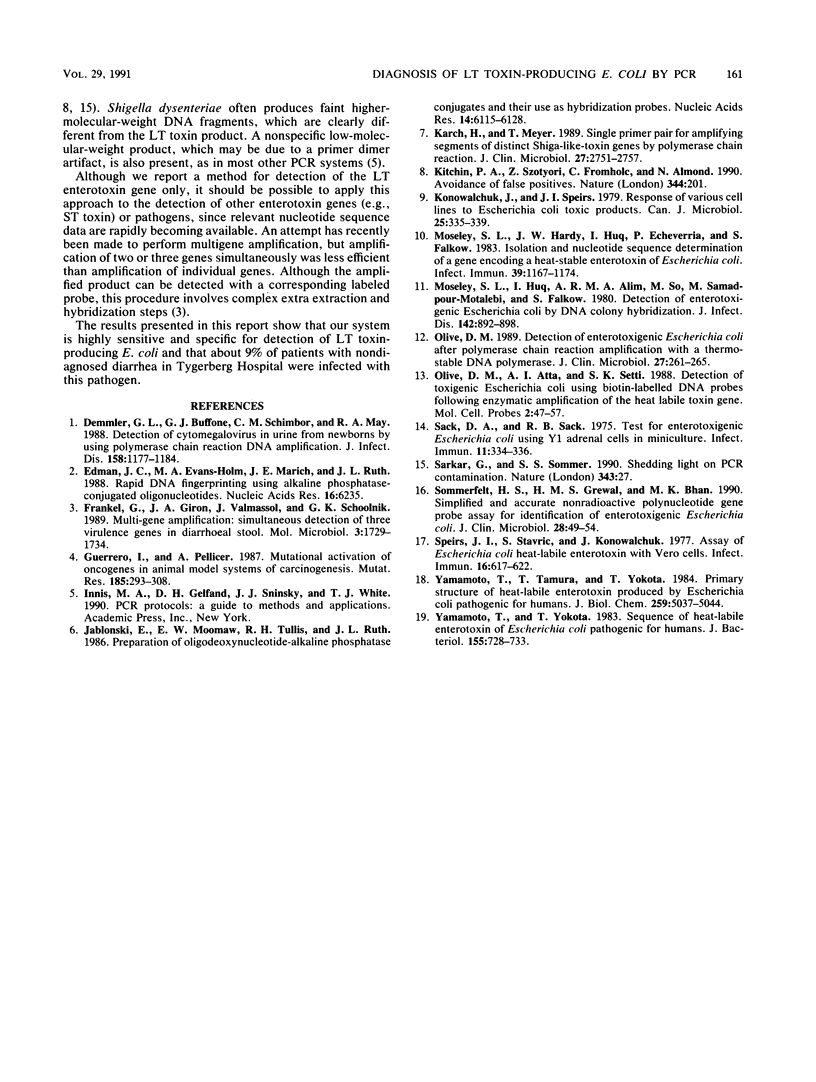Abstract
This report describes a DNA amplification procedure for routine identification of heat-labile-toxin-producing Escherichia coli. Two oligonucleotide primers were used in a polymerase chain reaction procedure to amplify a highly conserved region of the A subunit of the heat-labile enterotoxin gene. Amplifications were done directly on E. coli colonies from plates when Salmonella, Shigella, or parasite infections were excluded as agents of the severe diarrhea in the patients. The conditions for the polymerase chain reaction method were empirically determined, and the procedure is inexpensive, sensitive, and specific. Positive results can be obtained over a wide variation in bacterial numbers, with no inhibition of Thermus aquaticus DNA polymerase. Detection of the amplified product can be done by agarose gel electrophoresis, which is specific and sensitive enough for routine diagnosis of this pathogen in clinical isolates. If greater sensitivity and specificity are required, hybridization with 32P- or alkaline phosphatase-labeled oligonucleotide probes can be used. Our results suggest that heat-labile-toxin-producing E. coli is responsible for about 9% of nondiagnosed diarrhea cases in Tygerberg Hospital, Tygerberg, Republic of South Africa.
Full text
PDF



Images in this article
Selected References
These references are in PubMed. This may not be the complete list of references from this article.
- Demmler G. J., Buffone G. J., Schimbor C. M., May R. A. Detection of cytomegalovirus in urine from newborns by using polymerase chain reaction DNA amplification. J Infect Dis. 1988 Dec;158(6):1177–1184. doi: 10.1093/infdis/158.6.1177. [DOI] [PubMed] [Google Scholar]
- Edman J. C., Evans-Holm M. E., Marich J. E., Ruth J. L. Rapid DNA fingerprinting using alkaline phosphatase-conjugated oligonucleotides. Nucleic Acids Res. 1988 Jul 11;16(13):6235–6235. doi: 10.1093/nar/16.13.6235. [DOI] [PMC free article] [PubMed] [Google Scholar]
- Frankel G., Giron J. A., Valmassoi J., Schoolnik G. K. Multi-gene amplification: simultaneous detection of three virulence genes in diarrhoeal stool. Mol Microbiol. 1989 Dec;3(12):1729–1734. doi: 10.1111/j.1365-2958.1989.tb00158.x. [DOI] [PubMed] [Google Scholar]
- Guerrero I., Pellicer A. Mutational activation of oncogenes in animal model systems of carcinogenesis. Mutat Res. 1987 May;185(3):293–308. doi: 10.1016/0165-1110(87)90021-2. [DOI] [PubMed] [Google Scholar]
- Jablonski E., Moomaw E. W., Tullis R. H., Ruth J. L. Preparation of oligodeoxynucleotide-alkaline phosphatase conjugates and their use as hybridization probes. Nucleic Acids Res. 1986 Aug 11;14(15):6115–6128. doi: 10.1093/nar/14.15.6115. [DOI] [PMC free article] [PubMed] [Google Scholar]
- Karch H., Meyer T. Single primer pair for amplifying segments of distinct Shiga-like-toxin genes by polymerase chain reaction. J Clin Microbiol. 1989 Dec;27(12):2751–2757. doi: 10.1128/jcm.27.12.2751-2757.1989. [DOI] [PMC free article] [PubMed] [Google Scholar]
- Kitchin P. A., Szotyori Z., Fromholc C., Almond N. Avoidance of PCR false positives [corrected]. Nature. 1990 Mar 15;344(6263):201–201. doi: 10.1038/344201a0. [DOI] [PubMed] [Google Scholar]
- Konowalchuk J., Speirs J. I. Response of various cell lines to Escherichia coli toxic products. Can J Microbiol. 1979 Mar;25(3):335–339. doi: 10.1139/m79-053. [DOI] [PubMed] [Google Scholar]
- Moseley S. L., Hardy J. W., Hug M. I., Echeverria P., Falkow S. Isolation and nucleotide sequence determination of a gene encoding a heat-stable enterotoxin of Escherichia coli. Infect Immun. 1983 Mar;39(3):1167–1174. doi: 10.1128/iai.39.3.1167-1174.1983. [DOI] [PMC free article] [PubMed] [Google Scholar]
- Moseley S. L., Huq I., Alim A. R., So M., Samadpour-Motalebi M., Falkow S. Detection of enterotoxigenic Escherichia coli by DNA colony hybridization. J Infect Dis. 1980 Dec;142(6):892–898. doi: 10.1093/infdis/142.6.892. [DOI] [PubMed] [Google Scholar]
- Olive D. M., Atta A. I., Setti S. K. Detection of toxigenic Escherichia coli using biotin-labelled DNA probes following enzymatic amplification of the heat labile toxin gene. Mol Cell Probes. 1988 Mar;2(1):47–57. doi: 10.1016/0890-8508(88)90043-6. [DOI] [PubMed] [Google Scholar]
- Olive D. M. Detection of enterotoxigenic Escherichia coli after polymerase chain reaction amplification with a thermostable DNA polymerase. J Clin Microbiol. 1989 Feb;27(2):261–265. doi: 10.1128/jcm.27.2.261-265.1989. [DOI] [PMC free article] [PubMed] [Google Scholar]
- Sack D. A., Sack R. B. Test for enterotoxigenic Escherichia coli using Y-1 adrenal cells in miniculture. Infect Immun. 1975 Feb;11(2):334–336. doi: 10.1128/iai.11.2.334-336.1975. [DOI] [PMC free article] [PubMed] [Google Scholar]
- Sarkar G., Sommer S. S. Shedding light on PCR contamination. Nature. 1990 Jan 4;343(6253):27–27. doi: 10.1038/343027a0. [DOI] [PubMed] [Google Scholar]
- Sommerfelt H., Grewal H. M., Bhan M. K. Simplified and accurate nonradioactive polynucleotide gene probe assay for identification of enterotoxigenic Escherichia coli. J Clin Microbiol. 1990 Jan;28(1):49–54. doi: 10.1128/jcm.28.1.49-54.1990. [DOI] [PMC free article] [PubMed] [Google Scholar]
- Speirs J. I., Stavric S., Konowalchuk J. Assay of Escherichia coli heat-labile enterotoxin with vero cells. Infect Immun. 1977 May;16(2):617–622. doi: 10.1128/iai.16.2.617-622.1977. [DOI] [PMC free article] [PubMed] [Google Scholar]
- Yamamoto T., Tamura T., Yokota T. Primary structure of heat-labile enterotoxin produced by Escherichia coli pathogenic for humans. J Biol Chem. 1984 Apr 25;259(8):5037–5044. [PubMed] [Google Scholar]
- Yamamoto T., Yokota T. Sequence of heat-labile enterotoxin of Escherichia coli pathogenic for humans. J Bacteriol. 1983 Aug;155(2):728–733. doi: 10.1128/jb.155.2.728-733.1983. [DOI] [PMC free article] [PubMed] [Google Scholar]






